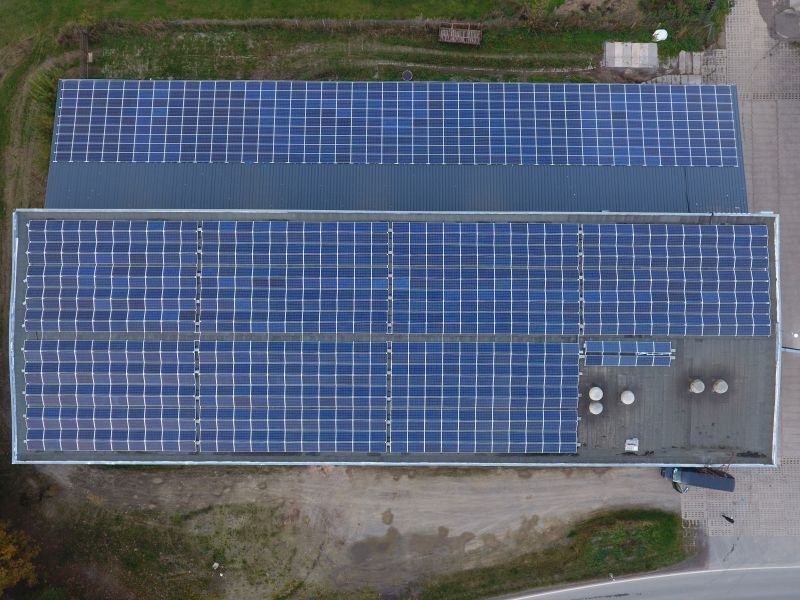Concerns that recent global events would curb the UK retail and manufacturing industries’ appetites for green energy initiatives are proving to be unfounded. However, with the future still uncertain, Christelle Barnes, UK Country Manager at SolarEdge Technologies, examines the role that renewable energy, and solar in particular, can play in helping retailers and manufacturers cut costs and safeguard their businesses against future large-scale disruptions.
It seems something of an understatement to say that the retail and manufacturing industries are experiencing a period of unparalleled change. While the Covid-19 pandemic spiked sales dramatically for UK supermarkets and leading online retailers, as well as for the manufacturers who supply them, there is no question that these operators face a myriad of, and for the most part, unprecedented, challenges. These include everything from dealing with the impact of supply chain disruptions and, at times, deserted high streets to navigating the impact of Brexit.
Against this turbulence, businesses across all industries are looking at ways to adapt their operational models and introduce new measures to drive long-term efficiencies, reduce costs and increase revenues. As budgets continue to come under greater scrutiny, or remain locked, this has led to speculation by industry watchers about whether some operators will pull back from investing in clean energy initiatives, especially in the face of falling energy prices. On the contrary, it seems that green energy is increasingly being viewed as an ‘ace’ card, offering businesses a pivotal way to ‘de-risk’ their operations by driving down energy costs.
For retailers and manufacturers, the argument to invest in renewable energy is especially compelling. Despite these industries’ attempts in recent years to reduce electricity consumption through the adoption of more energy-efficient technologies in areas such as lighting and refrigeration, electricity bills nevertheless remain high and are expected to remain so as more facilities move to 24-7 operation. According to a study carried out with the support of the Department for Environment, Food and Rural Affairs, retail food outlets alone currently account for 3% of the UK’s total electrical energy consumption. Or put another way, it is estimated that an average big-four format store typically incurs a staggering £400,000 in energy bills each year.
Amongst the companies pushing the sustainable envelope is Amazon. In 2020, the US-based retail giant invested in more than 4 GW of new solar and wind projects globally, which it claims is the largest corporate investment in renewable energy in a single year.
And it is certainly not alone. In November 2020, one of the UK’s leading supermarket chains announced plans for a major new clean energy project in partnership with a renewable energy investor. The project, which will see the creation of three solar farms, is expected to generate up to 130GW of energy each year – enough energy to power 44,828 three-bedroom houses – with any surplus energy being sold to the grid.
This type of partnership is typical of new funding models that commercial businesses are adopting to reduce the cost of investing in solar technology. With the high level of taxation imposed on businesses that buy their own solar technology, many are turning to power purchase agreements (PPAs) to utilise solar electricity with no upfront capital cost. With a PPA, the solar technology is purchased by a third-party company which then sells the energy back to its ‘customer’ at a discounted rate.
Solar comes to the fore
Of course, solar is not the only form of renewable energy generation, and there are many companies, Amazon included, that are choosing to invest in a combination of both solar and wind technology. This can often be the right approach, as each technology offers specific advantages and disadvantages. For example, while wind turbines typically deliver a high energy yield and are themselves very energy efficient, they take up a lot of space and usually require planning permission to install.
In contrast, solar is easier to install and maintain, and doesn’t usually require planning permission. What’s more, retail and manufacturing sites typically have large unused roofs that are capable of housing extensive PV systems. However, it is not only the practical considerations that make solar technology an increasingly attractive option for retail and manufacturing premises. Advances in solar technology are transforming performance – increasing energy yield, lowering operation and maintenance (O&M) costs through advanced monitoring capabilities, and increasing safety. As such, many UK retailers and manufacturers, large and small, are now seriously investigating solar as the preferred technology for managing their energy needs.
More energy, faster payback
So, what’s happened in the last few years that now makes solar so compelling? Well, development of more efficient solar module materials is one of the ways in which solar technology has been made more efficient and an ideal energy source for commercial premises. Of equal if not even greater importance are advancements in solar inverters. Solar inverters account for less than 10% of the cost of a typical solar application and yet are responsible for 100% of the energy generation. That’s why choosing the right inverter for your system has significant implications for its long-term financial performance.
In a traditional string inverter system, the inverter performs two main functions: DC to AC power conversion and maximum power point tracking (MPPT). The latter is responsible for extracting maximum power from the system. As MPPT is the most expensive component of any inverter system a common practice is to connect as many modules as possible to each MPPT. However, while this might save money initially, it builds inefficiency into the system which ends up costing the system owner much more in the long run.
This is because of the energy mismatch that occurs when modules operate at different efficiencies. There are many factors that can impact module performance, including ageing, manufacture tolerance variation, soiling, or shading from clouds or nearby trees. As string inverter systems require solar modules to be wired in a series, if a single module’s output is low, the efficiency of the entire string is reduced to the level of the lowest performing module.
In the event that a problem does occur, it is impossible, without a manual site inspection, to determine which module is at fault in traditional string inverter systems. This leaves maintenance staff with a difficult decision – leave the system to run at a suboptimal capacity or send out an engineer to try to identify and fix the underperforming module. This process can take many hours to complete, or even days, depending on the size of the installation.
As a result, we are seeing continued adoption of DC-optimised inverter systems. With this solution, the MPPT function is carried out by Power Optimizers placed directly onto solar modules, while a simplified inverter conducts DC to AC conversion and grid connection. This effectively isolates each module, ensuring that any faults or shading will also be isolated, thereby minimising mismatch-related power losses. The result is a much higher energy yield over the system’s lifetime – of typically between two and ten percent.
The ability to monitor solar installations at a module level also brings further cost savings through more efficient asset management. Should a module start to underperform, sensors in the Power Optimizer and inverter will automatically send an alert to the system owner’s laptop or smartphone, identifying the exact module at fault. This enables maintenance personnel to fix any performance issues quickly and efficiently, reducing the cost of maintenance call-outs and helping to keep energy losses to a minimum.
DC-optimised systems are proving especially beneficial for commercial business that are looking to reduce the lifetime cost of ownership of solar installations. By splitting the function of traditional inverters into two separate components, manufacturers are able to offer much longer warranties on those components – in the case of SolarEdge, warranties of 12 years for inverters and 25 years for Power Optimizers. This helps to de-risk investment in solar by ensuring that a system will perform at full capacity for far longer than traditional string inverter systems.
Putting safety first
With millions of solar systems installed worldwide, it is proven to be safe and reliable. However, as traditional solar installations can reach voltages as high as 1,500VDC, precautions should be taken to ensure the safety of people and assets.
To overcome potential risks, there are two safety features to look out for when investing in solar technology. The first is a safe DC feature. This is a panel-level safeguard which minimises the risk of electrocution during installation or standard system maintenance, or in the event of a fire. With traditional inverters, shutting down the inverter or the grid connection will terminate current flow, but DC voltage in the string cables will remain live for as long as the sun is shining, meaning the system still poses an electrocution risk. A safe DC feature overcomes this problem by automatically reducing the output voltage of each module to a touch-safe 1V.
Another feature to be aware of is arc fault detection. While uncommon, an electrical arc can be triggered by a number of events, from false trips to a loose connection. The U.S. has introduced strict arc detection standards which call for detection of specific arcs as they occur. While the UK Government has yet to implement a similar requirement, this is expected to change and may already be requested by insurance companies. So, it’s important not to get caught out.
Invest to de-risk
For many commercial facilities, the benefits of a renewable investment are very compelling. However, it’s important to gather all the facts before committing to a purchase. It’s a good idea to ask potential vendors to supply a levelized cost of energy (LCOE) assessment for their technology. This will include a breakdown of the proposed system’s cost of energy per kilowatt hour (kW/h) over its lifetime, enabling you to accurately benchmark both against competing brands and technologies.
It’s also important to remember that buying cheaper isn’t always the smartest choice. While a lower purchase price may look appealing on the balance sheet, any initial savings will be eroded if the system fails to generate sufficient energy, if maintenance costs are consistently high, or if the system develops a fault and the short warranty has already expired.
While retailers and manufacturers find themselves in uncertain times, the need to reduce OPEX has never been greater. This is why many are reviewing their energy costs and exploring the financial and sustainability benefits of renewables, quickly leading to the question of which technology to choose.
The case for solar has always been compelling, but with recent developments in module and inverter technology increasing the power efficiency, lifespan and safety of systems, many believe that there has never been a better time for businesses to invest in solar. Judging from the growing list of leading UK retailers and manufacturers doing exactly that, they could well be right.




